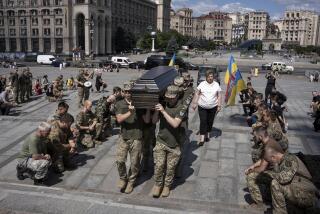Russian Planes Bomb Ice Jam
- Share via
MOSCOW — Russia’s air force Thursday launched an unusual bombing campaign--over its own territory--to blast away huge ice dams that have worsened spring floods for tens of thousands of people along the Lena River in remote eastern Siberia.
“It may seem strange that we are bombing our own country, but it is not the first time,” said Igor Tyurnev, a spokesman for the Emergency Situations Ministry, calling the action a necessity with 90% of the town of Lensk already under water.
“If the ice jam is not broken within the next two days, the level of water may continue to rise and cause more damage,” he said.
President Vladimir V. Putin ordered waves of airstrikes, with supersonic Sukhoi-24 fighter-bombers dropping 1,100-pound bombs on the Lena about 50 miles downstream from Lensk. Officials said towns and small settlements all along the stretch of river that winds northward into the Arctic Ocean are threatened by the rising waters.
Authorities said 96 bombs were dropped Thursday without breaking the ice dams, and more bombings were planned today. They insisted that there was no danger to the public from the bombing.
“You have to understand, this is Siberia,” another ministry spokesman, Sergei Bannikov, said in Moscow. “You drop a half-ton bomb and all you get is a hole in the ice, as if you are going fishing. The ice is that thick.”
He said some of the ice packs are 45 to 60 feet high, in a region where it is not unusual for temperatures to fall to minus 40 or even colder. “Very often, we have to combine bombings with planting explosives in the cracks of ice,” Bannikov said.
Meanwhile, helicopters were delivering food and evacuating residents from flooded homes. In Lensk, a town of 27,000, officials said 18,000 people had already been evacuated from their homes and were being housed in 14 emergency centers in the area.
The Lena River at Lensk reportedly is about 20 feet above flood stage. According to news reports, city officials said the water level had exceeded the worst-case predictions of experts and that a levee built in 1998 had been breached.
The nationwide ORT television news showed pairs of sleek fighter-bombers streaking over the town, which is covered with yellow-brown water up to its corrugated metal roofs. Rowboats and rubber dinghies were being used to rescue stranded residents. Some of those who had escaped to higher ground were cooking on campfires.
The river, which is more than 2,700 miles long, appeared to be carrying a slow-moving parade of broken ice as it passed Lensk. Officials said the ice pack downstream from the town is about 25 miles long.
The helicopters bringing relief supplies fly about 100 miles from an airfield in Mirnyi. The four Sukhoi fighter-bombers also are operating from the base.
The Interfax news agency quoted Deputy Emergency Situations Minister Ruslan Tsalikov as saying that pumps, potable water, tents, 2,000 sets of bedding, 360 gas stoves and 20 tons of foodstuffs were among the emergency supplies to be sent to the region.
One Mi-8 helicopter struck a power line and crashed as rescue workers retrieved people from a roof, said the ministry, but no casualties were reported.
According to Russian news agencies, both half-ton FAB-500 and quarter-ton FAB-250 bombs are being used by the air force. The larger bombs are about 8 feet long and typically leave a crater 130 feet in diameter.
Tyurnev, duty officer at the Emergency Situations Ministry of Sakha republic, said in a telephone interview from Yakutsk that the area being bombed is “absolutely deserted, with no villages or housing for dozens of miles around.”
Bannikov said aerial bombardment was frequently used in Soviet times.
But some ecologists said they are disturbed by the practice, even though they recognize that it must take place to save lives.
“The animal world will suffer once again in this struggle for human life,” said Alexei V. Yablokov, chairman of the Center for Ecological Policy of Russia.
“Of course, we may persuade ourselves that there is no way out of it right now--with that I agree. But it turns out that every year there is no way out, again and again and again. We keep resorting to the most primitive solution, to drop dozens of 500-kilogram bombs on our own nature--killing some of the last survivors of the rare Lena sturgeon, among other living organisms.”
Yablokov said he was convinced that there must be more “nature-friendly” ways to deal with the annual floods, such as building levees in high-risk areas and putting ice-breaking structures in the river.
Spring flooding is an annual occurrence in Russia, but the floods this year have been unusually severe after a particularly harsh winter in Siberia and fast warming in recent weeks. Across Russia, about 4,900 homes in 32 towns are under water, the Itar-Tass news agency reported, citing the Emergency Situations Ministry.
The floods have affected mostly rural areas, but some streets in major cities such as Irkutsk in eastern Siberia near Lake Baikal are also submerged, media reports said.
It was not the first use of bombing runs against floods this year. Three weeks ago, the air force dropped 14 bombs totaling more than 13 tons on the Biya River in the Altai region.
*
Sergei L. Loiko of The Times’ Moscow Bureau contributed to this report.
More to Read
Sign up for Essential California
The most important California stories and recommendations in your inbox every morning.
You may occasionally receive promotional content from the Los Angeles Times.













